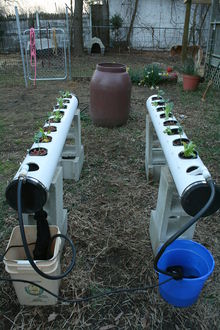- Nutrient film technique
-
Nutrient Film Technique or NFT is a hydroponic technique wherein a very shallow stream of water containing all the dissolved nutrients required for plant growth is re-circulated past the bare roots of plants in a watertight gully, also known as channels. In an ideal system, the depth of the recirculating stream should be very shallow, little more than a film of water, hence the name 'nutrient film'. This ensures that the thick root mat, which develops in the bottom of the channel, has an upper surface, which, although moist, is in the air. Subsequent to this, an abundant supply of oxygen is provided to the roots of the plants. A properly designed NFT system is based on using the right channel slope, the right flow rate, and the right channel length. The main advantage of the NFT system over other forms of hydroponics is that the plant roots are exposed to adequate supplies of water, oxygen and nutrients. In all other forms of production, there is a conflict between the supply of these requirements, since excessive or deficient amounts of one results in an imbalance of one or both of the others. NFT, because of its design, provides a system wherein all three requirements for healthy plant growth can be met at the same time, provided that the simple concept of NFT is always remembered and practiced. The result of these advantages is that higher yields of high-quality produce are obtained over an extended period of cropping. A downside of NFT is that it has very little buffering against interruptions in the flow, e.g., power outages, but, overall, it is one of the more productive techniques.
The same design characteristics apply to all conventional NFT systems. While slopes along channels of 1:100 have been recommended, in practice it is difficult to build a base for channels that is sufficiently true to enable nutrient films to flow without ponding in locally depressed areas. As a consequence, it is recommended that slopes of 1:30 to 1:40 be used. This allows for minor irregularities in the surface, but, even with these slopes, ponding and water logging may occur. The slope may be provided by the floor, or benches or racks may hold the channels and provide the required slope. Both methods are used and depend on local requirements, often determined by the site and crop requirements.
As a general guide, flow rates for each gully should be 1 litre per minute. At planting, rates may be half this, and the upper limit of 2L/min appears about the maximum. Flow rates beyond these extremes are often associated with nutritional problems. Depressed growth rates of many crops have been observed when channels exceed 12 metres in length. On rapidly growing crops, tests have indicated that, while oxygen levels remain adequate, nitrogen may be depleted over the length of the gully. As a consequence, channel length should not exceed 10–15 metres. In situations where this is not possible, the reductions in growth can be eliminated by placing another nutrient feed halfway along the gully and reducing flow rates to 1L/min through each outlet.[1]
References
Categories:
Wikimedia Foundation. 2010.

